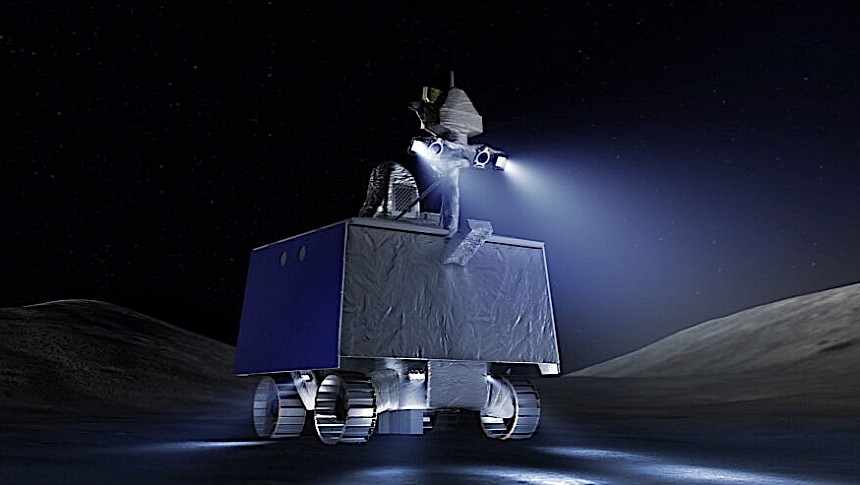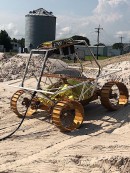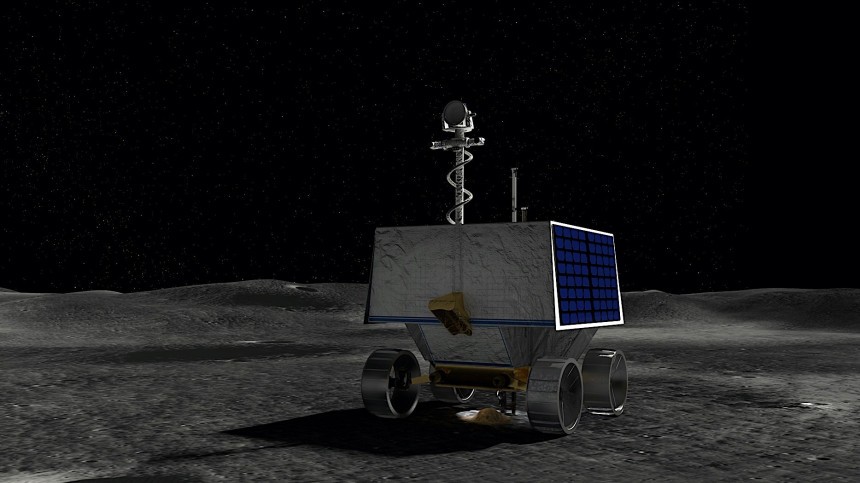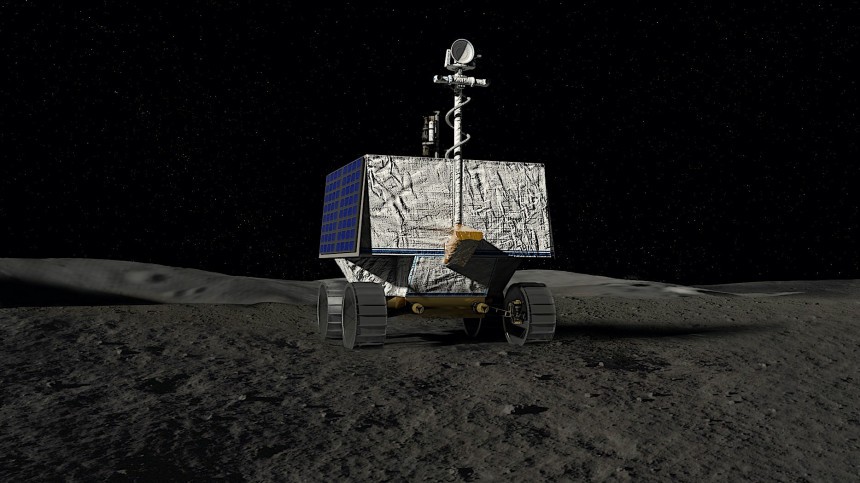Cars that are autonomous to some degree are already a reality of our time. With the exception of a single carmaker, however, no one really dares say their cars are fully self-driving, for the simple reason they are not.
The difficulty of making a truly autonomous vehicle to roam the roads of our planet does not necessarily come from the limitations of artificial intelligence (AI) systems, or those of detection hardware, but from the complexities that make driving on Earth something that can only be properly handled (at least for now) by human beings.
Knowing that you'd think automated driving is perfectly suited for use on other worlds, powering rovers and other such gear sent up there by our species on exploratory missions. You'd think wrong, as it appears NASA does not trust itself enough to fully put AI in charge of a rover mission to the Moon.
At the end of next year, the lunar south pole will receive an important robotic visitor. It's called Volatiles Investigating Polar Exploration Rover, or VIPER, and it is tasked with a simple yet crucial mission: find and map water so it can be used in situ by the crewed missions planned to land there.
NASA relies heavily on AI not only to make the rover suitable for the task, but also to plan its movements on the Moon. We've already discussed an AI system called SHERPA (System Health Enabled Real-time Planning Advisor), built to help the team running the VIPER rover get a better sense of the crucial aspects of navigation in the dangerous environment on the Moon.
Like most rovers sent to other worlds by our species, this one too uses cameras and software suites. They are used to get a better sense of the environment around the rover and detect potential hazards.
But while Earth-going cars pack both the cameras and sensors inside themselves, the VIPER only carries the cameras with it. The SHERPA software doesn't even make the trip to the Moon, and it is only deployed here on Earth as a means to inform humans of their choices.
So, why does NASA not give the AI system the reigns of the mission and let it decide where best to send the rover? The answer might surprise you.
You all know how an artificial intelligence system is only as good as the data used to train it. And although NASA has a lot of data about the Moon, it completely lacks the experience of what driving a robotic rover on the Moon is all about.
That's because despite being the only space agency to have sent people to the Moon and several successful rovers to Mars, NASA has never landed a robotic rover on the lunar surface.
In a nutshell, it doesn't trust itself enough to teach the AI all it should know to make this a safe enough automated mission, so it takes a more cautious approach by "keeping humans in the loop," in a bid to balance out the risks and rewards of using AI for science purposes.
So SHERPA will not become the first AI to actually drive a rover on the Moon. It will instead be used to create maps of the rover's mission area, and trained with the existing tools at NASA's disposal.
Those tools include first and foremost the hundreds of photographs snapped from lunar orbit by a spacecraft called Lunar Reconnaissance Orbiter. Data of VIPER's operating area obtained with the help of a laser shot down at the surface to see how long it takes for it to bounce back up is also being used.
That data is used to create a model of the lunar terrain for the NASA team to look at as it plans the VIPER mission. The model is not only useful for the rover to be directed properly, but also for it to be steered clear of shadow areas that would spell doom for the solar-powered device – the thing uses a solar-charged battery with a peak power of 450 watts.
So SHERPA is being used by NASA's mission planners not as a driver per se, but to "assess the various risks of different routes […] and even provide contingency branches for where to go if something changes or doesn't go according to plan."
As for the VIPER itself, we're talking about a machine that is the size of a golf cart and weighs 992 pounds (450 kilograms). When it launches on top of a SpaceX Falcon Heavy rocket next year it will become the heaviest cargo NASA has ever sent into space using the rockets of one of its commercial partners.
The planned duration of the mission is only 100 days, but that can be extended if all goes according to plan, as it happened so many times before in the history of space exploration.
Knowing that you'd think automated driving is perfectly suited for use on other worlds, powering rovers and other such gear sent up there by our species on exploratory missions. You'd think wrong, as it appears NASA does not trust itself enough to fully put AI in charge of a rover mission to the Moon.
At the end of next year, the lunar south pole will receive an important robotic visitor. It's called Volatiles Investigating Polar Exploration Rover, or VIPER, and it is tasked with a simple yet crucial mission: find and map water so it can be used in situ by the crewed missions planned to land there.
NASA relies heavily on AI not only to make the rover suitable for the task, but also to plan its movements on the Moon. We've already discussed an AI system called SHERPA (System Health Enabled Real-time Planning Advisor), built to help the team running the VIPER rover get a better sense of the crucial aspects of navigation in the dangerous environment on the Moon.
Like most rovers sent to other worlds by our species, this one too uses cameras and software suites. They are used to get a better sense of the environment around the rover and detect potential hazards.
But while Earth-going cars pack both the cameras and sensors inside themselves, the VIPER only carries the cameras with it. The SHERPA software doesn't even make the trip to the Moon, and it is only deployed here on Earth as a means to inform humans of their choices.
You all know how an artificial intelligence system is only as good as the data used to train it. And although NASA has a lot of data about the Moon, it completely lacks the experience of what driving a robotic rover on the Moon is all about.
That's because despite being the only space agency to have sent people to the Moon and several successful rovers to Mars, NASA has never landed a robotic rover on the lunar surface.
In a nutshell, it doesn't trust itself enough to teach the AI all it should know to make this a safe enough automated mission, so it takes a more cautious approach by "keeping humans in the loop," in a bid to balance out the risks and rewards of using AI for science purposes.
So SHERPA will not become the first AI to actually drive a rover on the Moon. It will instead be used to create maps of the rover's mission area, and trained with the existing tools at NASA's disposal.
Those tools include first and foremost the hundreds of photographs snapped from lunar orbit by a spacecraft called Lunar Reconnaissance Orbiter. Data of VIPER's operating area obtained with the help of a laser shot down at the surface to see how long it takes for it to bounce back up is also being used.
So SHERPA is being used by NASA's mission planners not as a driver per se, but to "assess the various risks of different routes […] and even provide contingency branches for where to go if something changes or doesn't go according to plan."
As for the VIPER itself, we're talking about a machine that is the size of a golf cart and weighs 992 pounds (450 kilograms). When it launches on top of a SpaceX Falcon Heavy rocket next year it will become the heaviest cargo NASA has ever sent into space using the rockets of one of its commercial partners.
The planned duration of the mission is only 100 days, but that can be extended if all goes according to plan, as it happened so many times before in the history of space exploration.



















